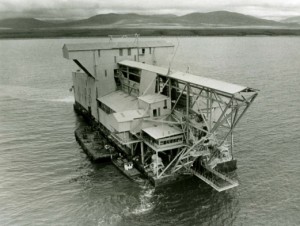
Bucket-Ladder dredges are very complex systems which require a large, highly skilled crew to operate. They tend to be custom built for specific conditions. An initial cost will range from several million to 10s of millions depending on the production and depth of operation. Accuracy is a function of vessel management usually achieved with spuds or anchors which is an art in its self. Their ability to reach near shore shallow areas is limited by their draft and the sea state. Bucket ladders can easily achieve 10km3/day and operate to depths in excess of 50m. Bottom coverage is nearly 100%, but the depth of cut is influenced by surface conditions, especially in rough seas. Under excavation will result in lost gold and a higher spillage rate. Since all of the material is excavated to the surface for separation, the environmental impact will be high with regard to material displacement and surface plume[i].
Historical BIMA Benchmark
The BIMA, a 565 foot long bucket-ladder dredge operated by West Gold from 1987 to 1990 is the largest dredge to ever be mobilized in Nome. The initial purchase price was about $4,000,000 while an additional $15,000,000 was invested in the retrofit for Nome mobilization. During the trials and 4 years of operation, the BIMA experienced hull damage from ice, was hindered by rough seas and was shut down due to a broken drive shaft[III].
The BIMA did not proved to be economically viable, but it did set the high bar for material removal and gold recovery. These numbers will be used to establish a baseline for competing technologies to reference. The market price for gold at the time was around $400/oz., the current $1,300/oz. price makes a comparable operation much more profitable.
Historic figures show that over its four-year period, the BIMA averaged 1,114,400m3/year of excavated material. For an average of 100 operational days per year, this equates to 11,114m3/day or 464m3/hr. This data is quantified in Table 1 below.
Table 1: BIMA Data
| BIMA Benchmark – Historic 4-Year Period | ||
| Total Dredged Volume | 4,457,602 | m3 |
| Duration | 4 | years |
| Average Season | 100 | days |
| Daily Average | 11,144 | m3/day |
| Hour Average | 464 | m3/hr. |
By processing this material, they were able to average 295 oz. per day. Here, we assume this ‘free gold’ had a fineness of .89 fine. In today’s market, this production would average over $340,000 per day in gross revenue before operating expenses and taxes.
[i] Vlasblom W.J. (2004, Feb). Bucket (Ladder) Dredge, WB3408B Lecture Notes. Retrieved from http://www.dredging.org/content.asp?page=105
[III] Turner W. (1987, Oct. 13). Information-BIMA Dredge, Dredging the Bering Sea for Some of What Glitters. Special to the New York Times